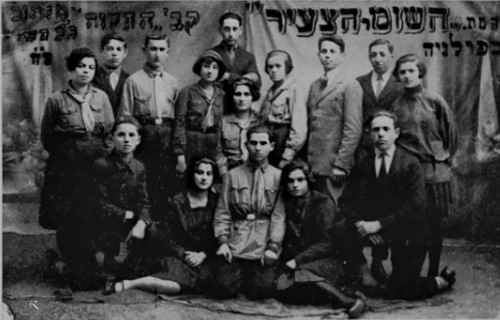 |
|
|
[Page 460]
Translated by Howard I. Schwartz, PhD
©
|
|
| The group, HaTikvah (“The Hope”) [a group of] “Hashomer Hatzair” in Mlynov[1] |
|
|
| Members of [Zionist Youth Group] HeHalutz [“The Pioneer”], Mlynov |
[Page 461]
|
|
| [original caption is confused][2] Shlomo Schechman [first from left],[3] Yidel Liberman, z”l [third from left],[4] Avraham Goldseker [standing second from right],[5] Avraham Goldseker [=Chuna Goldsker,[6] seated front], and to be distinguished for a long life, Pinchas Klaper[7] [first from right] and Pesach Mandelkern [second from left][8] Original courtesy of Irene Fishman and Audrey Goldseker Polt |
|
|
| Graduation of Grade 7 in the government school (1938). May he be distinguished for a long life the teacher Barshtchovko Alexander (in the middle above) |
[Page 462]
|
||||
| Hannah [Schuchman] Golisuk, Gershon's [daughter],[9] her son Shmuel and daughter Tzvia, z”l | ||||
|
|
|||
| Rivitz Pesia z”l[10] (daughter of Aizik Wolf from Shalbia) |
Sherman Moshe, his wife Etel [Golisuk] z”l[11] |
|||
[Page 463]
|
|
|
|||||
| Pesich Golisuk z”l | Yosel Golisuk z”l | Motia Golisuk z”l |
|
|
|
|||||
| Bunia [Steinberg] Upstein and her mother [Hanah (Lerner) Steinberg] |
Mendel and Faiga Upstein [Steinberg][12] | Moshe and Zalman Zider and their families, z”l[13] |
|
|
|||
| Fania Grinberg[14] [right] and Batia Holzeker[15] | Goldreich family (from the refugees of Turka)[16] |
Editor's footnotes:
|
|
JewishGen, Inc. makes no representations regarding the accuracy of
the translation. The reader may wish to refer to the original material
for verification.
JewishGen is not responsible for inaccuracies or omissions in the original work and cannot rewrite or edit the text to correct inaccuracies and/or omissions.
Our mission is to produce a translation of the original work and we cannot verify the accuracy of statements or alter facts cited.
 Mlyniv, Ukraine
Mlyniv, Ukraine
 Yizkor Book Project
Yizkor Book Project
 JewishGen Home Page
JewishGen Home Page
Copyright © 1999-2026 by JewishGen, Inc.
Updated 23 May 2022 by LA